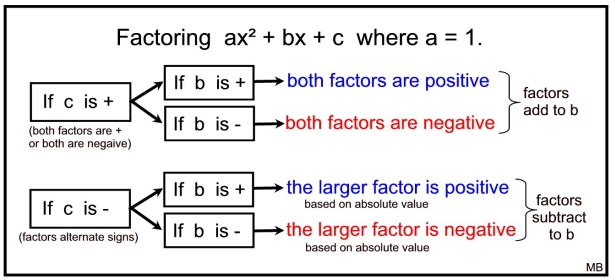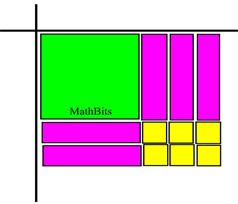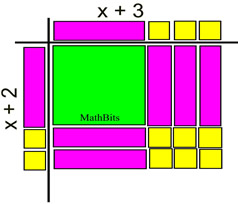|
"We will be examining quadratic trinomials of the form ax2 + bx + c."
 Part 1: Trinomials with a = 1 (ax2 + bx + c) Part 1: Trinomials with a = 1 (ax2 + bx + c) |
|
If we multiply (x - 4)(x + 3), we get x2 - x - 12.
In terms of factoring, (x - 4) and (x + 3) are the binomial factors of the trinomial x2 - x - 12.
In this section we will be given a trinomial with a = 1.
Our job is to find the binomial factors that will create that trinomial.
Method 1: Trial and Error
Factor: x2 - x - 12 |
Step 1: The first step when factoring is to always check for a common factor among the terms. Since the leading coefficients in this section are always "1", there is no common factor (other than 1). |
Nope!
Due to leading coefficient of 1. |
Step 2: To get the leading term of x2, each first term of the factors will need to be x. |
(x )(x ) |
Step 3: The product of the last terms must be -12. Unfortunately, there are a variety of ways to arrive at this product of -12.
| |
+12 and -1
-12 and +1
+6 and - 2
-6 and +2
+4 and -3
-4 and +3
|
ALL of these pairings
yield a product of -12.
But only ONE of them
is the correct choice!
|
|
Possible answers?
(x + 12)(x - 1)
(x - 12)(x + 1)
(x + 6)(x - 2)
(x - 6)(x + 2)
(x + 4)(x - 3)
(x - 4)(x + 3)
|
Step 4: Only one of the possible answers shown above will be the correct factoring for this problem. Which choice, when multiplied, will create the correct "middle term" needed for this example?
As we multiply through the various options, we discover that the needed middle term for this problem is "-x".
Wow! That was a lot of work! |
(x + 12)(x - 1) middle term +11x
(x - 12)(x + 1) middle term -11x
(x + 6)(x - 2) middle term +4x
(x - 6)(x + 2) middle term -4x
(x + 4)(x - 3) middle term +x
(x - 4)(x + 3) middle term -x
|
Step 5: Write the answer. |
x2 - x - 12 = (x - 4)(x + 3) |

Could there possibly be an easier way to factor a trinomial?
Method 2: Observable Pattern
Let's see if there is a pattern in this process. |
The "important" values in these trinomials (in relation to factoring)
are the last term and the coefficient of the middle term. |
| Trinomial |
Factors |
Observations: |
|
x2 + 6x + 8
last term = 8
middle coefficient = 6
|
(x + 4 )(x + 2)
|
multiply 4 • 2 = 8
add 4 + 2 = 6 |
x2 - 2x - 3
last term = -3
middle coefficient = -2
|
(x + 1 )(x - 3)
|
multiply 1 • (-3) = -3
add 1 + (-3) = -2 |
x2 - 7x + 10
last term = 10
middle coefficient = -7 |
(x - 2 )(x - 5)
|
multiply (-2) • (-5) = 10
add (-2) + (-5) = -7 |
Pattern:
x2 + (a + b)x + (a • b)
last term = a • b
middle coefficient = (a + b)
|
(x + a)(x + b) |
a • b = last term
(a + b) = middle coefficient |
This pattern exists only in quadratic trinomials with a leading coefficient of "1".
While the pattern does not give you the exact values you will need to find the factors, it does tell you "how" the values you need are related to one another.
You need to find values that multiply to the last term, and at the same time, add to the middle coefficient.
|
So, yes, there is a shorter way to find the answer!
If the coefficient of x2 is 1,
then x2 + bx + c = (x + m)(x + n)
where m and n multiply to give c
and m and n add to give b.
|
|
In plain English:
If the leading coefficient is 1,
you need to find
"numbers that multiply to the last term
and add to the middle term's coefficient!"
Be careful of the signs of the numbers!

Factor relationships dealing with b and c when a = 1.


Could a coefficient of "1" be hiding!
It may be the case that a trinomial with a leading coefficient other than "1", may actually have a leading coefficient of "1", after you factor out the Greatest Common Factor!
Method: Leading Coefficient of "1" in Hiding!!
Factor: 3x2 - 3x - 36 |
Step 1: The first step when factoring is to always check for a common factor among the terms. This trinomial contains a greatest common factor of 3.
Factor out 3 from each term.
|
3(x2 - x - 12)
|
Step 2: YEA!!! We now have a trinomial with a leading coefficient of "1" and we can apply our Pattern Method".
We are looking for numbers that multiply to -12 and add to -1.
The numbers must be -4 and +3.
Don't forget to carry along the GCF of 3, that we factored out at the beginning,
into your final answer. |
3(x - 4)(x + 3)
DONE! |

Method: Using Algebra Tiles

The graphing calculator can prove to be helpful for checking your answer when factoring over the set of integers. |
|
For help with factoring on your calculator,
Click Here!
|
|
|

NOTE: The re-posting of materials (in part or whole) from this site to the Internet
is copyright violation
and is not considered "fair use" for educators. Please read the "Terms of Use". |
|



 See more about
See more about 

